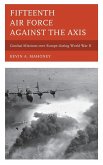This undertaking is a work of unusual form. At its core this work is a database covering Anglo- American strategic bomber operations against Germany, Italy, and Axis associated or occupied Europe. As such it allows swift and easy listing of day-by-day bombing, bombing of strategic target systems by location and tonnage, bombing of specific countries, comparisons of US and British targeting and operations, and much more. The work details strategic operations only- B-17 and B-24 bomber sorties by the four US numbered air forces in the European and Mediterranean theaters (Eighth, Ninth, Twelfth, and Fifteenth) and all bombing sorties for aircraft assigned to the Royal Air Force (RAF) Bomber Command and RAF 205 Group. This definition excludes US twin-engine medium bomb groups, which often hit the same aiming points as their four-engine compatriots, but includes twin-engine British Wellington medium bombers and twin-engine British Mosquito, Boston, and Ventura light bombers. Although the US heavy and medium bombers had instances of overlapping, targeting those instances usually fell into areas of what US doctrine defined as tactical rather than strategic bombing, such as frontline troops, transportation facilities feeding the front line, and airfields. US medium bombers did not fly deep into enemy country to attack industrial and strategic targets. The case differed for the RAF. Wellingtons and other medium bombers formed the backbone of the main bombing force from 1940 through late 1942 and throughout 1943 for 205 Group. Bomber Command's shortranged Bostons and Venturas of No. 2 Group raided French ports, power plants, and industrial targets until transferring to Tactical Bomber Force in May 1943. Likewise, Mosquitoes conducted numerous hit-and-run daylight raids until May of 1943 and then switched to night harassing attacks on German population centers, particularly Berlin, until the war's end. Such bombing furthered Bomber Command's campaign against the morale of the German labor force.
Hinweis: Dieser Artikel kann nur an eine deutsche Lieferadresse ausgeliefert werden.
Hinweis: Dieser Artikel kann nur an eine deutsche Lieferadresse ausgeliefert werden.








